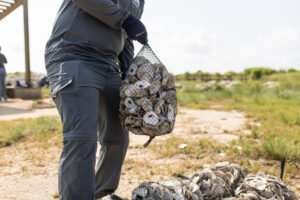The Vital Role of Oysters in Galveston Bay: Recycling, Restoration, and Resilience
- August 06, 2024
- News

Galveston Bay is one of Texas’s most cherished natural treasures and among its many inhabitants, oysters hold a special place. As we strive to balance human activity with environmental stewardship, the importance of oysters in Galveston Bay has never been clearer. This blog is meant to give you background on why these remarkable mollusks matter, how local initiatives are making a difference, and how recycling oyster shells is crucial for their future.
The Ecological Significance of Oysters
Check out how these oyster hometown heroes perform a host of vital functions in Galveston Bay:
- Water Filtration: Oysters are natural filter feeders. One oyster can filter up to 50 gallons of water per day, removing excess sediment and particulates. This helps maintain the bay’s water quality and clarity, benefiting other marine life and improving overall ecosystem health.
- Habitat Formation: Oyster reefs create complex structures that serve as essential habitats for a variety of marine species. These reefs offer shelter and breeding grounds for fish, crabs, and other organisms, fostering a diverse and productive marine community.
- Shoreline Protection: Oyster reefs act as natural barriers against coastal erosion. Their presence helps stabilize sediments and reduce the impact of storm surges, providing a buffer that protects both natural and human-made shorelines.
Recycling Oyster Shells: A Simple Yet Effective Solution
A very promising strategy for addressing oyster reef depletion is recycling oyster shells. Organizations from states along the Pacific, Atlantic, and Gulf Coast states are implementing this approach. When oysters are consumed in restaurants, their shells can be repurposed to help rebuild reefs. Here’s how this process works and why it’s so effective:
- Collection and Cleaning: We use our truck and trailer and custom dump truck to collect discarded oyster shells from restaurants that participate in our recycling program, the shells are then dumped at one of our curing sites where they stay quarantined for at least six months to remove any residual contamination. This step is crucial to prevent the spread of disease and ensure the shells are suitable for reef restoration.
- Reef Restoration: Once fully cured, the shells are transported to designated restoration sites in Galveston Bay. These sites are carefully chosen to optimize reef development and ensure the best conditions for oyster larvae to settle and grow. The recycled shells serve as a foundation for new oyster reefs, providing a substrate where young oysters can attach and thrive.
- Ongoing Monitoring: Restoration efforts are complemented by regular monitoring to assess the health and growth of the reefs. This data helps refine techniques and ensure that restoration projects are achieving their goals.

Our Local Clear Lake, Galveston, and Houston Restaurants are Making a Difference
Nearly 40 restaurants from Houston to Galveston are leading the charge in oyster shell recycling. These partnerships have proven invaluable. By participating in our shell recycling program, these establishments contribute directly to the health of Galveston Bay. Take a look at our restaurants who are incorporating shell recycling into their sustainability practices, recognizing the broader environmental benefits of their contributions.

The Future of Oysters in Galveston Bay
The restoration and protection of oyster reefs in Galveston Bay is a collaborative effort that involves the community, businesses, and conservation organizations. As we continue to recycle oyster shells and support reef restoration initiatives, we enhance the resilience of the bay’s ecosystem and help secure a future where oysters can thrive.
In essence, the health of Galveston Bay is intricately linked to the health of its oyster populations. By embracing shell recycling and supporting reef restoration, we contribute to a balanced and thriving ecosystem that benefits everyone—from the smallest marine organisms to the local communities who cherish this unique and beautiful bay.
So next time you enjoy oysters, remember that your shell could be part of a larger effort to restore and protect one of our most vital natural resources. Together, we can ensure that Galveston Bay remains a vibrant, healthy, and resilient environment for generations to come.




